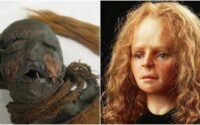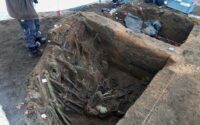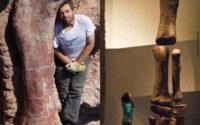The Lima Mummy Mystery: A 1,000-Year-Old Chancay Find Sparks Internet Intrigue .bongbenh
The Lima Mummy Mystery: A 1,000-Year-Old Chancay Find Sparks Internet Intrigue
Introduction
On June 18, 2025, a routine gas pipeline project in Lima, Peru, unearthed a discovery that sent shockwaves through the online community: a 1,000-year-old pre-Inca mummy, linked to the Chancay culture, found just 20 inches beneath the bustling streets of the Puente Piedra district. The find, announced by the utility company Cálidda and shared widely on X by accounts like @Archaeology_Mag and @SmithsonianMag, revealed a teenager, aged 10 to 15, buried in a seated position with arms and legs bent, wrapped in a shroud alongside ceremonial objects. The tomb, marked by a huarango tree, included intricately decorated ceramics and calabash gourds, hinting at a ritualistic burial from a coastal fishing society that thrived between 1000 and 1470 AD. Yet, conflicting reports about the mummy’s gender, age, and the cryptic nature of the artifacts sparked a viral frenzy on X, with hashtags like #LimaMummy and #ChancayMystery trending globally. Was this a noble youth, a sacrificial victim, or something stranger? This article explores the discovery, the science behind it, and the online speculation that has turned a 1,000-year-old grave into a modern enigma.
The Discovery: A Tomb Beneath the City
The find occurred during a routine excavation by Cálidda workers laying natural gas pipelines in northern Lima’s Puente Piedra district, a former agricultural area now transformed into working-class neighborhoods. At just 20 inches (50 cm) below Santa Patricia Avenue, workers uncovered the trunk of a huarango tree, a species historically used as a tomb marker by pre-Inca cultures along Peru’s arid coast. Recognizing the significance, they halted construction and called in archaeologists, who unearthed a remarkably preserved mummy at a depth of 1.2 meters. The body, wrapped in a funerary shroud, was seated with bent arms and legs, its dark brown hair still intact, a testament to the natural preservation of Peru’s desert climate.
The tomb was a treasure trove of artifacts: nine ceramic vessels—plates, jugs, and bottles—adorned with black-on-white and tricolor patterns depicting geometric motifs and fishermen in headdresses, alongside four calabash gourds filled with shellfish. These grave goods, identified as hallmarks of the Chancay culture, suggested a ceremonial burial, possibly of someone significant. Archaeologist José Aliaga, working with Cálidda, noted the burial’s consistency with Chancay practices, while Jesús Bahamonde, the company’s archaeological coordinator, speculated the individual belonged to a society of fishermen. But early reports sowed confusion: some, like AP News, described the mummy as female, while others, including Smithsonian Magazine, identified it as a boy aged 10 to 15, igniting online debates about the find’s true nature.
The Science: Unraveling a Chancay Burial
The Chancay culture, flourishing from 1000 to 1470 AD in the valleys of the Chancay and Chillón rivers, was a coastal society known for its fishing, agriculture, and intricate artistry, including black-on-white pottery and fine textiles like gauze and embroidered cloth. Their burials often featured mummified bodies in seated positions, naturally preserved by the dry coastal climate, with hands sometimes covering the face to signify spiritual protection. The Lima mummy’s preservation, with intact hair and skin dehydrated by heat, aligns with these practices, though some sources suggest cultural mummification techniques may have been used. The presence of a huarango tree as a tomb marker and the inclusion of ritual objects like shellfish-filled gourds point to a belief system tied to the sea, possibly honoring the deceased’s role or status.
The mummy’s age—estimated at 10 to 15 years—raises intriguing questions. Chancay burials often included grave goods reflecting social status, and the finely crafted ceramics suggest this youth held significance, perhaps as a community member or ritual figure. However, the shallow burial, just 20 inches below a modern street, is puzzling. Lima, home to over 500 archaeological sites, is a city built atop layers of history, with Cálidda alone uncovering over 2,200 artifacts since 2004. Yet, how did such a significant burial remain undetected amid decades of urban sprawl? The discrepancy in gender reports—female in some sources, male in others—further complicates the narrative, as no DNA analysis has been publicly shared to clarify the individual’s identity.
The Online Frenzy: A Viral Vortex of Theories
The discovery hit X like a thunderbolt, with posts from @Dr_TheHistories and @Purebliss33 amplifying its reach. The hashtag #LimaMummy trended alongside #ChancayMystery, as users marveled at the find’s preservation and speculated about its meaning. Comments ranged from awe (“A 1,000-year-old kid with hair intact? Mind blown!”) to confusion (“Boy or girl? Why can’t they agree?”). The artifacts, particularly the fisherman-themed ceramics, sparked fascination, with some sharing images of Chancay cuchimilco statues—clay figurines with open arms often buried as guardians. But the conflicting reports and the burial’s shallow depth fueled a wave of theories that turned the mummy into an internet enigma.
1. The Noble Youth Theory
Many users hypothesized the mummy was a high-status individual, possibly a young noble or ritual figure. The elaborate ceramics and shellfish offerings suggested wealth or importance, as noted by archaeologist Jesús Bahamonde, who speculated the individual was part of a fishing society. A thread by @HistoryDiggerX proposed the teenager was a “chosen youth” buried with honors, perhaps linked to Chancay religious practices. Others countered that the shallow burial contradicted elite status, as prominent figures were typically interred deeper or in huacas (sacred cemeteries). The debate over gender—boy or girl—added fuel, with users demanding DNA results to settle the question.
2. The Sacrificial Victim Hypothesis
A darker theory emerged: the teenager was a sacrificial offering. X users like @AncientSecretsX pointed to the seated position and ritual objects, comparing them to Andean practices where young individuals were sometimes sacrificed to appease deities. The shellfish gourds, possibly symbolizing the sea, were seen as evidence of a maritime ritual. This theory gained traction after @Purebliss33 referenced a 2021 Chancay find with ropes suggesting ritual binding, hinting at a ceremonial death. Skeptics argued the burial’s care—fine ceramics and a shroud—implied respect, not sacrifice, but the idea of a “sea offering” captivated conspiracy enthusiasts.
3. The Misidentified Burial Theory
Skeptics on X, led by @TruthSeeker22, questioned whether the mummy was truly Chancay. The shallow burial, just 20 inches deep, seemed improbable for a 1,000-year-old tomb in a city as developed as Lima. Some speculated the remains were from a later period, possibly colonial, misattributed to the Chancay due to the ceramics. A now-deleted post claimed Cálidda’s archaeologists rushed to label the find for publicity, citing the company’s history of over 2,200 discoveries as evidence of “overzealous” reporting. Others noted the gender discrepancy—female in AP News, male in Smithsonian—suggested sloppy science or media errors, fueling hashtags like #LimaHoax.
4. The Alien or Supernatural Theory
In the internet’s wilder corners, a fringe group proposed extraterrestrial or supernatural origins. A user named @CosmicDigz claimed the mummy’s preservation and the fisherman motifs hinted at an “ancient astronaut” connection, linking the Chancay to myths of sea gods or alien visitors. The huarango tree, seen as a “cosmic marker,” inspired fan art of the mummy as a starborn figure. While ridiculed, the theory spawned memes of “Chancay aliens” and #MummyFromSpace, adding a surreal twist to the discourse.
The Community’s Divide: Awe vs. Doubt
The online response was a clash of wonder and wariness. Archaeology enthusiasts celebrated the find, with @Archaeology_Mag’s post garnering thousands of retweets and users sharing Chancay pottery images to highlight the culture’s artistry. Educational accounts used #LimaMummy to explain natural mummification, boosting interest in Peru’s heritage. Lima’s residents, like @PeruPride, expressed pride, noting the city’s 500+ archaeological sites as a “living museum.” The find inspired virtual tours of Chancay sites and calls to protect Peru’s heritage amid urban growth.
But skepticism ran rampant. Hashtags like #ChancayCoverUp and #MummyMixup emerged, with users demanding DNA results to clarify the mummy’s gender and age. A thread by @SkepticScribe analyzed the ceramics’ photos, claiming their pristine condition suggested modern replicas or misidentification. Others questioned why a significant burial was so shallow, speculating it was planted or disturbed during colonial times. The lack of updates from Cálidda or Peru’s Ministry of Culture, which oversees the find, fueled accusations of a staged discovery, with one user, @DigTheTruth, writing, “If this is real, where’s the follow-up? Show us the lab results!”
Investigating the Enigma: What We Know
Efforts to verify the mummy’s story are ongoing but inconclusive. Archaeologists, led by José Aliaga and Jesús Bahamonde, are analyzing the remains under the Ministry of Culture’s supervision, but no DNA or isotopic data has been released to confirm gender, age, or diet. The huarango tree’s role as a tomb marker aligns with Chancay practices, and the ceramics match known artifacts, but the gender discrepancy—female in some reports, male in others—remains unexplained. Lima’s history of urban development over 500 archaeological sites explains the shallow burial, as construction often disturbs ancient layers, yet the mummy’s preservation raises questions about undisturbed survival.
A lead surfaced on X when @LimaLocal claimed to have witnessed the excavation, describing a “hushed” dig site with security barring onlookers. The post, deleted within hours, hinted at “unusual” artifacts not mentioned in reports, like a metal object uncharacteristic of Chancay craftsmanship. This fueled rumors of a suppressed find, though no evidence supports this. Reverse image searches of the mummy’s photos, shared by @SmithsonianMag and @Dr_TheHistories, matched only news reports, confirming their authenticity but offering no new clues. The promised “further studies” by Cálidda have yet to materialize, keeping the mystery alive.

The Broader Implications: History Beneath Our Feet
The Lima mummy underscores the delicate balance between urban growth and heritage preservation. Lima, a city of 10 million built on three Andean-fed rivers, has been a cradle of civilization for millennia, with Chancay and other cultures leaving a rich archaeological tapestry. Cálidda’s 2,200+ finds since 2004 highlight the frequency of such discoveries, mandated by Peru’s laws requiring archaeological oversight during construction. Yet, the mummy’s shallow burial and conflicting reports reflect the challenges of studying history in a modern metropolis, where artifacts lie just beneath the surface.
The online frenzy reveals the internet’s dual nature: a platform for celebrating history and questioning narratives. The mummy’s story, blending scientific rigor with tantalizing gaps, has captivated X, where users project hopes, doubts, and wild theories onto a 1,000-year-old teenager. The gender confusion, shallow grave, and unrevealed “extraordinary” details—whether real or media errors—mirror the internet’s love for ambiguity, driving engagement through mystery.
Conclusion
As of July 4, 2025, the Lima mummy remains a 1,000-year-old enigma, its seated form and fisherman-themed ceramics a window into the Chancay’s world, yet shrouded in questions. Was this teenager a revered figure, a ritual sacrifice, or a misidentified relic? The conflicting reports, shallow burial, and silent follow-up have turned #LimaMummy into a digital Rorschach test, blending awe with suspicion. Until DNA results or new artifacts surface, the Chancay youth will keep X buzzing, as the internet chases answers beneath the streets of Lima, where history and mystery lie just 20 inches apart.


